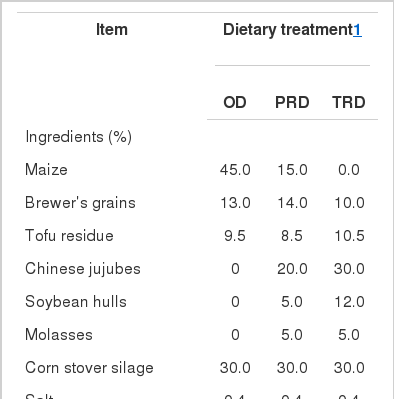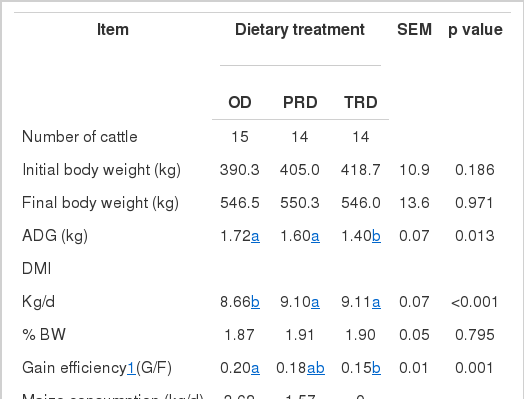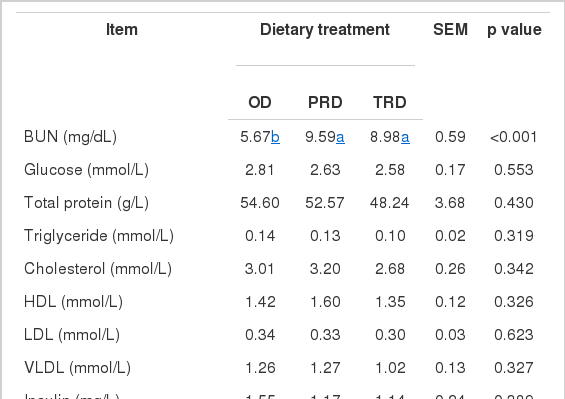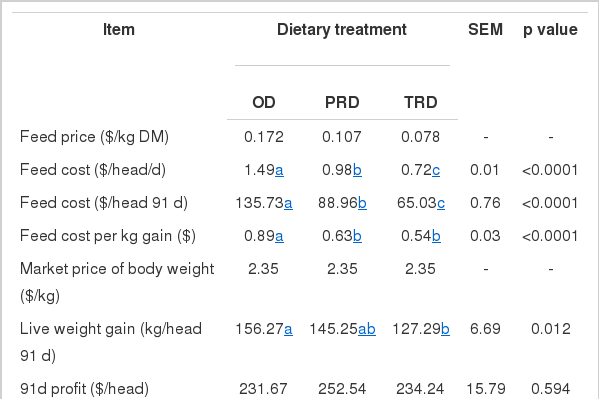Effects of Partial or Total Replacement of Maize with Alternative Feed Source on Digestibility, Growth Performance, Blood Metabolites and Economics in Limousin Crossbred Cattle
Article information
Abstract
Increasing cost and scarcity of maize has stimulated the use of alternative feed sources (AFS) in the diets of cattle. In this study, we investigated the effects of partial or total replacement of maize on nutrient digestibility, growth performance, blood metabolites, and economics in Limousin crossbred feedlot cattle. Forty-five Limousin×Luxi crossbred bulls were randomly assigned to the three treatment groups, orthodox diet (OD; 45.0% maize), partial replacement diet (PRD; 15% maize, 67% AFS), total replacement diet (TRD; 0% maize, 100% AFS). The growth feeding trial lasted for 98 days. Dry matter intake (DMI) and average daily gain (ADG) were recorded. The digestion trial was carried out after the end of the growth trial. Total faeces and feed samples were measured daily. Digestibilities of dry matter (DM) and organic matter (OM), crude protein (CP), neutral detergent fiber (NDF) and acid detergent fiber (ADF) were calculated. After the feeding trial, blood metabolites were measured in 12 animals from each group. Initial and final body weights did not differ significantly among treatment groups (p>0.05). The ADG and DMI were 1.72 and 8.66, 1.60 and 9.10, and 1.40 and 9.11 kg/d for OD, PRD, and TRD, respectively. The PRD and TRD exhibited lower ADG (p<0.01) and higher DMI (p<0.01) than OD. The DMI (%body weight) was comparable between groups (p>0.5). Feed efficiency of PRD and TRD were lower than OD (p<0.01). The DM digestibility decreased with reduced level of maize (p = 0.10), OM digestibility was higher in OD (p<0.05), and CP, NDF and ADF digestibilities were similar for all groups (p>0.05). Blood urea nitrogen (mg/dL) in PRD and TRD was higher than OD (p<0.01), while other blood parameters did not differ significantly. Feed costs ($/head/d) were 1.49, 0.98, and 0.72 for OD, PRD, and TRD, respectively (p<0.01). Feed costs per kg gain ($) were significantly lower for PRD (0.63) and TRD (0.54) than OD (0.89; p<0.01). Overall profit ($/head) and daily profit ($/head/d) did not differ significantly between treatments (p>0.05), although TRD showed the highest economic benefits overall (p<0.01). While a traditional diet maximized the growth rate, partial or total replacement of dietary maize with AFS proved economically feasible due to their lower costs and comparable nutrient digestibilities of DM, CP, NDF, and ADF. Partial replacement may prove economically competitive in the current situation of China.
INTRODUCTION
Maize (Zea mays L.) is a major energy source in the diet of livestock. Like other cereals, maize is in short supply and costs are increasing due to its use as biofuels. In China, maize is the mainstay of the feedlot industry, with feeds containing up to 60% maize. More expensive maize increases the market price of beef, and this is a major concern for feedlot cattle production in China. Replacing maize with alternative feed sources (AFS) such as Chinese jujubes, brewer’s grains or tofu residues may prove economically advantageous. These foods have in fact been fed to domesticated animals for millennia (Bampidis and Robins, 2006). In China, 840 million tons of crop residues, 30 million tons of brewer’s grains, and 15 million tons of by-products from the processing of soybean curd, rapeseed oil and potato starch are generated every year. However, these by-products are currently underutilized as animal feeds, with only a third of crop residues, a fifth of brewer’s grains, and a third of the other by-products utilized as ruminant feeds (Lin, 2009). Being readily available, cheap and relatively high in nutrient content, these by-products represent a valuable resource for feeding livestock, as well as for reducing the environmental impact of farming.
Brewer’s grains and soybean curd (tofu) residue are often used as a source of protein in cattle feeding in China, and dried distillers grains with solubles (DDGS), which are readily digestible, contain a large amount of neutral detergent fiber (NDF), and are low in lignin. Beef cattle have been successfully reared on DDGS constituting up to 400 g/kg of total ration dry matter (DM) (Larson et al., 1993; Ham et al., 1994; Al-Suwaiegh et al., 2002). Vander Pol et al. (2006) also reported that up to 30 to 40% wet distillers’ grains could be used in cattle feed without losing optimum performance. Soybean curd residue remains after soybeans are ground and the water extractable fraction is used to produce soymilk and tofu. Wang and Cavins (1989) found that tofu residue contain 30% soybean solids, 20% soybean protein, and 11% oils. Previous research showed that the average daily gains in Holstein steers were not significantly different when half or all dietary soybean meal was replaced with dry tofu residue (Wang et al., 2004). Chinese jujube (Zizyphus jujuba Miller) is an indigenous dried fruit that has been consumed for 4,000 years. Chinese jujube trees have been widely planted in reforested areas of the Yellow River valley, where they are well suited both ecologically and economically (Yuan et al., 2002). Chinese jujubes output is considerable (2.59 million tons according to the Statistical Yearbook of Chinese Agriculture, 2011) and accounts for 90% of total world production (Yuan et al., 2002). Top quality jujubes are used as a dry fruit and herbal medicine, and lower quality fruits are currently discarded, which is wasteful and causes environmental pollution. Li et al. (2009) reported that jujubes contain 80.9% to 85.6% carbohydrate, 57.6% to 77.9% reduced sugars, 0.6% to 2.8% soluble fiber, 5.2% to 7.2% insoluble fiber, 4.8% to 6.9% protein, 0.4% to 1.0% lipid, 17.4% to 22.5% moisture and 2.3% to 3.0% ash. Recently, farmers in China have begun to use lower quality fruits as beef cattle feeds.
Partial replacement of maize with AFS such as brewer’s grains, tofu residues or Chinese jujubes in cattle feeds was reported to increase economic benefits, despite impaired growth (Wang et al., 2004; Vander Pol et al., 2006). However, the effects on growth of partially or totally replacing maize in beef cattle with AFS have not been reported, and neither have the economic considerations. The aims of this study were to investigate the effects on nutrient digestibility, growth performance, blood metabolites and profit margins of partial or total replacement of maize with AFS in the diets of feedlot cattle.
MATERIALS AND METHODS
Animals, experimental design and diets
All animal procedures were conducted as recommended by the Animal Welfare Committee of the China Agricultural University. A feeding trial was conducted using 45 Limousin×Luxi breed bulls (purchased from Shandong Province, China) (18 months old, 404.3±28.6 kg initial body weight) in a single factorial completely randomized design. Animals were assigned randomly to three dietary treatment groups (15 animals per group): orthodox diet (OD; 45.0% maize), partial replacement diet (PRD; 15% maize, 67% AFS), and total replacement diet (TRD; 0% maize, 100% AFS). Maize, brewer’s grains, tofu residue, and maize stover silage were obtained from Beijing, while Chinese jujubes, soybean hulls and molasses were purchased from Hebei Province. Feed ingredients and nutrient composition are listed in Table 1. Diets were formulated to contain a minimum of 2.40 Mcal/kg metabolizable energy (ME), 11.82% crude protein (CP), 0.61% Calcium and 0.42% Potassium to meet or exceed NRC (2000) requirements. During the experiment, all animals fed OD, PRD or TRD diets were healthy and exhibited normal ingestion, rumination and excretion behavior, with the exception of leg injuries (due to accidental) in two animals from PRD and TRD groups, respectively, and these two animals were removed from the statistical analyses.
Feeding management
The trial lasted for 98 days from April 2012 to July 2012 (7 days adaptation, 91 days data collection). After adaptation, bulls were weighted and randomly assigned to one of the three diets. Initial and final body weights (BW) were obtained by averaging two measurements on consecutive days. Animals were individually tethered and fed twice daily at 6:00 am and 17:00 pm. Enough feed was supplied to ensure feeding troughs mostly empty in the following morning. If troughs were completely clean for two consecutive mornings, 500 g of mixed diet was added to the daily ration. Animals had free access to fresh water throughout the feeding trial. All refusals were collected, weighed, and recorded before the next feeding day to evaluate the daily intake of DM and other nutrients, and representative samples were chemically analyzed.
Digestion trial and blood collection
After the feeding trial, six animals from each group were randomly selected, housed individually, and fitted with fecal collection bags to evaluate nutrient digestibility. Bags were emptied twice daily at 6:00 and 17:00, about twenty minutes was used every time. For each 24 h period, total fecal weight was determined, and 10% of the combined feces of each bull were sprayed with 10% (w/v) sulfuric acid (to prevent ammonia loss), dried in a forced-air oven at 55°C for at least 72 h, and ground in a ZN-02 Wiley Mill (Beijing Xingshilihe Technology Development Co., Ltd., Beijing, China) to pass through a 1 mm screen for subsequent analyses of OM, CP, NDF, acid detergent fiber (ADF), and other parameters. Dietary samples and refusals were also taken daily and combined for similar analyses. After the digestion trial, blood samples were taken from 12 bulls in each group, centrifuged at 3,000×g for 15 min, and the supernatant (plasma) was stored at −20°C.
Laboratory analyses
Diets and fecal samples were analyzed in duplicate for DM, Ash, and CP using Association of Official Agricultural Chemists (AOAC) official methods 934.01, 942.05, and 968.06 (1990), respectively. Concentrations of NDF and ADF were sequentially determined using the method of Van Soest et al. (1991) in a batch processor (Ankom Technology Corp., Fairport, NY, USA), and NDICP and ADICP were determined using combustion method 968.06 (AOAC, 1990). Starch was determined as described by Xiong et al. (1990), and total digestible nutrient (TDN) was calculated using the formula reported by Weiss (1993). The ME, digestible energy (DE), net energy for maintenance (NEm), and net energy for gain (NEg) were calculated according to the method of the NRC (1984) as shown below. All samples were analyzed for Ca by AOAC (1990) procedure 927.02. Blood samples were analyzed for blood urea nitrogen (enzyme-coupling method), total protein (biuret method), glucose (hexokinase method), cholesterol (enzymatic), triglycerides (enzymatic method), high-density lipoprotein (HDL, direct one-step) low-density lipoprotein (LDL, direct one-step) and very low-density lipoprotein (VLDL, direct one-step), insulin (enzyme-linked immunosorbent assays), alkaline phosphatase (benzene disodium phosphate method), lactate dehydrogenase (UV spectrophotometer) with a 7600 Automatic Biochemical Analyzer (Hitachi, Tokyo, Japan) and kits were purchased from Nanjing Jiancheng Biological Engineering Institute.
where FA = fatty acids, NDFN = NDF-NDICP (neutral detergent insoluble crude protein), and all values are expressed as a percentage of DM.
Economic return
The economic return value, expressed as the ratio of output to input, is calculated based on feed price, bulls body weight, and growth performance as follows:
where ADG is the average daily gain (kg/head), MPBW is the average market price of body weight ($/kg), DMI is the daily DM intake (kg/head/d), and MPF is the market price of feeds (Xie et al., 2012).
Statistical analyses
Data are presented as the means of each treatment with pooled standard errors of the mean. All data were analyzed using the general linear model procedure of SAS (2000). Significant differences (p<0.05) among means were tested using Duncan’s New Multiple Range Test at 5% significance level. Treatment effects were declared significant at p<0.05 and considered a tendency for 0.05<p<0.15 unless otherwise noted.
RESULTS
Nutrient digestibility
The dietary DM intake did not differ significantly (Table 2) between treatment groups (p>0.05), although fecal DM in OD was significantly lower than PRD and TRD (p<0.01). Replacing maize with AFS significantly decreased OM digestibility (p<0.018), however no effect was evident on DM, CP (p>0.11), NDF and ADF (p>0.5) digestibilities.
Growing performance
The effects of replacing maize with AFS on growth performance of feedlot cattle (Table 3) showed that the initial and final body weights (kg) did not differ significantly between groups (p>0.05). The TRD exhibited the lowest ADG (p<0.01), and ADG of PRD and OD was comparable (p>0.05). The DMI of PRD and TRD were higher than OD, whereas DMI expressed as % BW did not differ significantly between groups (p>0.05). Gain efficiency (G/F) showed no significant difference (p>0.05) between PRD and OD, however TRD was significantly lower (p<0.01), indicating that maize free diet treatment resulted in the lowest feed conversion efficiency.
Blood metabolites
The effects of replacing maize with AFS on blood metabolites (Table 4) showed that BUN of PRD and TRD were significantly higher (p<0.01) than OD. No differences were detected for other blood parameters including glucose, total protein, triglyceride, cholesterol, HDL, LDL, VLDL, insulin, alkaline phosphatase and lactic dehydrogenase.
Economic analysis
The economics of replacing maize with AFS (Table 5) showed that the feed price ($/kg DM) was 0.172, 0.107, and 0.078 for OD, PRD, and TRD, respectively. Daily feed cost ($/head/d) was 1.49, 0.98, and 0.72 for OD, PRD, and TRD, respectively, which was a significant difference between groups (p<0.01). The total feed cost ($/head) for all 91 days was also significantly different (p<0.01) between OD (135.73), PRD (88.96), and TRD (65.03). The cost per kg gain ($) for PRD and TRD were significantly lower than OD (p<0.01); PRD (0.63) was 0.26 lower than OD, and TRD (0.54) was 0.35 lower than OD. The overall profit ($/head) and daily profit ($/head/d) did not differ significantly between groups (p>0.05), but the economic benefits of OD, PRD, and TRD were significantly different (p<0.01), with OD providing the lowest economic benefit.
DISCUSSION
Chemical composition of feeds and diets
Chemical compositions of feed ingredients (Table 6) showed that brewer’s grains and tofu residues had much higher CP, NDF, and ADF content than maize-based feed, but lower TDN, ME NEm, NEg and starch content. In contrast, Chinese jujubes had lower CP and ME, but higher NDF, ADF and sugar content. Molasses also had lower TDN, ME NEm, NEg and starch content, but higher sugar content. Therefore, partial or total replacement of maize with AFS (brewer’s grains, tofu residue and Chinese jujubes) reduced ME content but increased NDF and ADF, while dietary CP content was unaffected. When AFS were formulated to replace maize, the ME content of OD, PRD, and TRD diets was 2.61, 2.47, and 2.40 Mcal/kg DM, respectively (Table 1). The growing performance decreased with increasing AFS, which is to be expected due to the lower TDN, ME NEm, and NEg content, and the higher levels of fiber in these diets.
Nutrient digestibility
In the present study, digestibilities of DM, CP, NDF, or ADF were similar in all dietary groups, but OM digestibilities for PRD and TRD were significantly lower than those of OD. In general, the digestibility of DM and OM is changed in a same manner. The inconsistency in the digestibilities of dietary DM and OM changed with AFS replacement of maize is not clear. We assume that this inconsistency reflects errors from sampling and determination process, and is not a biological difference. The digestibilities of DM, CP, NDF, and ADF obtained from this study were similar to Mahgoub et al. (2005), who reported that the digestibility coefficient decreased as the proportion of non-conventional feed ingredients increased. This may be explained by the higher fiber content compared to traditional diets. Previous studies also showed that supplements high in digestible fiber can supply energy in a form that maintains ruminal pH and fiber digestibility (Horn and McCollum, 1987; Bowman and Sanson, 1996). Eun et al. (2009) observed that providing DDGS in the diet increased NDF digestibility, and Zhou et al. (2006) reported that increasing dietary NDF levels linearly increased the apparent digestibility of dietary NDF and ADF in Chinese Holstein bulls. In contrast, Nellore lambs fed diets containing NDF levels of 58.1%, 54.5%, and 52.7% showed similar ADF digestibility, although the NDF digestibility was highest for the lowest NDF containing diet (Nagalakshmi et al., 2011). In this study, the dietary NDF content (% DM) was similar for OD, PRD, and TRD, therefore a similar digestibility of DM, CP, NDF, and ADF was expected for the three groups.
Finishing performance
Previous reports stated that dairy cows could tolerate reasonably high dietary NDF levels (up to 42.9%) and high NDF intake without a major reduction in total DMI when high fibrous AFS are included in an alfalfa silage-based diet (Horn and McCollum, 1987; Batajoo and Shaver, 1994; Bowman and Sanson, 1996). In the present study, DMI (kg/d) of PRD and TRD were higher than OD, whereas there was no significant difference between groups when DMI was expressed as % BW. The part reason for the higher DMI of PRD and TRD relative to OD is the fast digestion rate of soybean hulls, Chinese jujubes and molasses included for replacement of maize grains in the diet. As illustrated by McDonald et al. (2011), ruminant intake is actually more closely related to the rate of digestion of diets than to digestibility per se. The better palatability of soybean hulls, Chinese jujubes and molasses compared to maize grain may be another factor enhancing the dietary intake. Compared with OD, PRD, and TRD exhibited lower ADG and G/F, although no significant differences in ADG and G/F were observed between OD and PRD groups. These results are inconsistent with those of Eun et al. (2009), who reported that dietary DMI decreased as more DDGS were included in the diet, whereas ADG and G/F were improved by including DDGS for all inclusion levels. Similar results were also observed when animals were fed high level non-conventional feeds (Abdullah and Abddel Hafes, 2004; Mahgoub et al., 2004). The former results of lower OM digestibilities of PRD and TRD than OD (shown in Table 2) is partly responsible for this decrease in ADG and G/F with the increase of dietary AFS replacement level. Likewise, TDN and energetic values (ME, NEm, and NEg) in PRD and TRD groups (Table 1) were lower than those in OD group. Thus, even though PRD and TRD groups had higher DMI per day than that of OD group, the increased DMI might not fully compensate for the reduced dietary energy and proteins as the maize is replaced with AFS in the diet. As a result, the decreased growth rate and G/F with the increase of dietary AFS replacement level observed from this study would be expected. However, when the consumption of cereal grains in cattle feeding, such as maize in this study, was taken into account, feeding the diet to ruminants with less or no cereal grains would be a great priority, especially in developing countries.
Blood metabolites
Blood metabolites are important indicators of general health and vitality, and may reflect the function of certain tissues and organs. The BUN is a product of protein and amino acid catabolism in the body, and negatively correlates with nitrogen deposition and protein or amino acid utilization. When amino acids are limited or imbalanced, or when decreased utilization of protein occurs, BUN content increases (Ponnampalam et al., 2005). In ruminants, degradation of nitrogenous compounds releases ammonia, and microbes in the rumen use this ammonia to synthesize bacterial proteins, stabilizing rumen ammonia concentrations. Therefore reduced blood ammonia concentrations can result in lower BUN levels. In this study, BUN levels in PRD and TRD were significantly higher than OD (p<0.01), suggesting amino acid levels in OD were well balanced and the rate of protein utilization was higher than in other dietary groups. Blood glucose plays an important role in temporary energy storage in tissues, organs and the central nervous system under normal physiological conditions, and provides a convenient physiological index of overall energy metabolism. Changes in blood triglycerides, cholesterol, HDL, LDL, VLDL, total protein, and alkaline phosphatase and lactate dehydrogenase levels can be used as indicators of fat and protein metabolism, and liver function. In this study, the above parameters were not significantly different between groups (p>0.05), indicating that partial or total replacement of maize with AFS in the diet of growing bulls did not adversely affect sugar, protein and lipid metabolism. The effects on tissues and organs were not investigated specifically but were assumed to be minimal given the above results.
Economic effects
In the present study, PRD and TRD costs were lower because AFS are now much cheaper than maize. In particular, Chinese jujube is free except for collection and transportation costs. Similar results (Al Jassim et al., 1998; Abo Omar, 2002; Obeidat et al., 2008) were reported using lambs fed non-conventional feeds (meskit pods and sesame cake). Typical feeding conditions and low feed price both contributed to cost savings, and Cruz et al. (2010) previously observed that G/F alone, or DMI and ADG together, could explain 98.5% of the variance in cost of body weight gain. In this study, the G/F of OD was higher than PRD and TRD, which decreased feed costs to some extent. However, due to having the highest daily feed cost, OD group produced the lowest economic benefits, indicating that replacing maize partially or completely with AFS seems economically feasible due to their lower cost. However, whether the high replacement of cereal grains with AFS has any adverse impact on beef quality remains under further investigation.
CONCLUSION
The present study showed that partial replacement of maize with AFS had no adverse effects on body weight gain in feedlot cattle, whereas total replacement reduced the body weight gain. The feed price and feed cost per kg gain were markedly reduced when maize was replaced with AFS. Although the OD supported the highest growth rates, partially or totally replacing maize proved economically feasible due to their low cost and similar digestibilities of DM, CP, NDF, and ADF. The PRD (67% maize replaced by AFS) appears to be suitable, although the impact on beef quality needs to be assessed.
ACKNOWLEDGMENTS
This study was financially supported by The grants of Chinese Agricultural Research System (CARS-38), Chinese Universities Scientific Fund (2013QJ071) and Beijing & Central University Joint Project (201202910411136).





